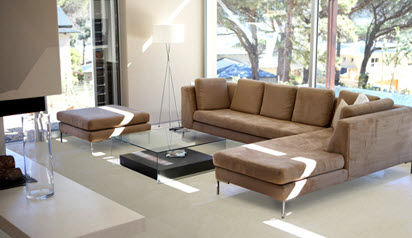
Engineered stone tiles are a tough, low maintenance type of tile that can be made to look like most types of natural stone.

Engineered stone tiles can be made to look very much like natural stone tiles. Photo by Quarella.
What are ‘engineered stone’ tiles?
These tiles can look and feel just like different types of natural stone (e.g. granite, limestone, marble etc.), but they’re actually made from a mixture of crushed rock and a resin or a bonding agent. Because it’s so hard, quartz is usually the type of stone that’s favoured for producing engineered stone, but things like marble and limestone are also used, depending on what kind of finish and properties are required.
The quartz (or whichever stone’s used) normally makes up about 93% of the mixture, with the resin accounting for most of the other 7%. The exact amounts will differ depending on the look, brand, and manufacturing process.
Other solid elements like small bits of glass, mirror or shells can also be added to the mix, as can different colour pigments, depending on the desired effect – and for that reason engineered stone tiles come in a broad and varied range of styles.
Engineered stone has become very popular in recent years – although mostly for benchtops (e.g. Caesarstone, which is a well-known brand of engineered stone). People occasionally confuse engineered stone with the naturally occurring ‘quartzite’ stone – no doubt as a result of the word ‘quartz’ in the name.
What are the properties of engineered stone tiles?
Engineered stone has a very low porosity, which means that unlike most natural stones, it doesn’t need to be regularly resealed to ensure it doesn’t absorb things and stain. It’s also very hard and durable, and stacks up admirably against most types of natural stone tile in that respect. Some people argue that in terms of these properties, it’s equal to sealed granite.
How are engineered stone tiles made?
Engineered stone tiles are pretty similar in terms of their composition to terrazzo, although that’s mixed on site, poured wherever it’s needed, left to set and then polished in place. Engineered stone, on the other hand, is industrially produced in large slabs by mixing together the ingredients and then allowing them to set in slabs. These slabs are then polished and either cut down for use in benchtops and similar surfaces, or sliced into tiles.
The engineered stone we buy today is largely the product of a long series of technical refinements and pioneering by an Italian company company called Breton, which has been inventing and producing machinery to manufacture engineered stone since the 1960’s.
Until fairly recently, all engineered stone was produced in a handful of locations around the world by companies using Breton machines and their patented “vibrocompression vacuum process”.
These days though, much of the engineered stone on the market is manufacturered in plants using machines produced in China – and much of the engineered stone on the market is produced in either China or India.
Common and standard sizes for engineered stone tiles
Tiles cut from engineered stone slabs are usually between 9mm and 30mm thick, depending on the thickness of the slabs.
Standard sizes for engineered stone tiles are usually:
- 300mm x 300mm
- 400mm x 400mm
- 600mm x 300mm
- 600mm x 400mm
- 600mm x 600mm
What to look for when choosing engineered stone tiles
Some brands and selections of engineered stone will be manufactured with more care than others, so it’s worth shopping around and knowing what you’re buying. While you will get strong warranty assurances from most established brands using Breton machines to produce their tiles, that doesn’t mean tiles produced by reputable manufacturers in China or India aren’t necessarily just as good.
When you’re choosing tiles, consider:
- Price – if the price is unusually low, this should probably set off some alarm bells.
- Colour and style – naturally you’re going to want something that suits.
- Size – bigger tiles may allow for a more ‘seamless’ look if that’s what you’re after.
- Warranty – as well as the length of the warranty, it’s a good idea to consider how long the company’s been around and how well established it is in Australia. A ten year warranty sounds great, but it’s worthless if the company has no material assets in Australia and it disappears into thin air a year after your tiles are installed.
|
Advantages
|
Disadvantages
|





